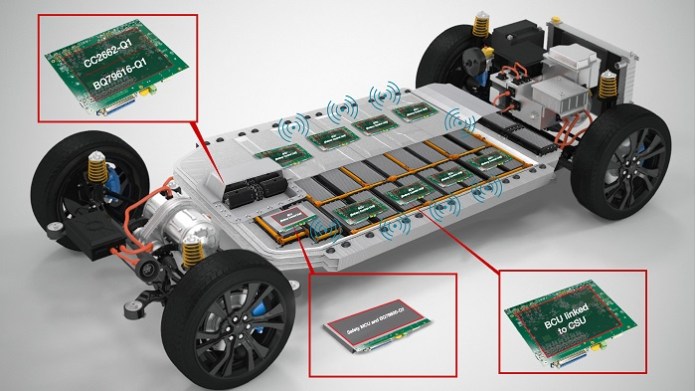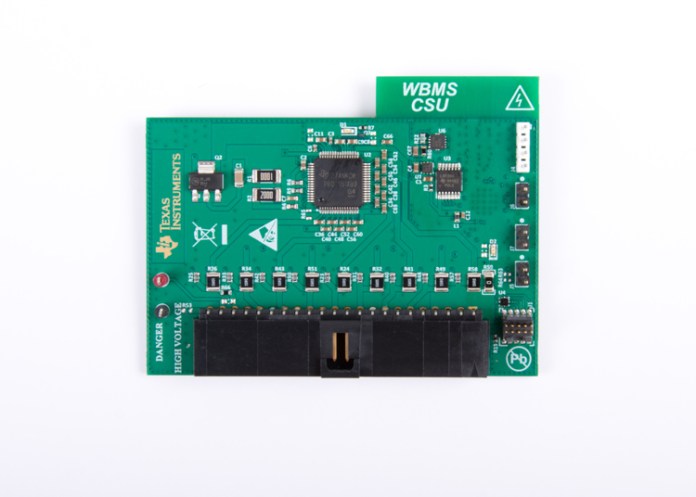Targeting the challenges associated with wiring and safety concerns for electric vehicles (EVs), Texas Instruments (TI) has released a wireless battery management system (BMS) solution that enables ASIL-D systems with a wireless protocol, while simplifying the wiring system, reducing design complexity, and extending driving range.
TI said the wireless BMS is the first independently assessed functional safety concept through TÜV SÜD. The safety organization evaluated the quantitative and qualitative error-detection performance of TI’s wireless BMS functional safety concept as well as the feasibility for automakers to achieve ISO 26262 ASIL-D. The assessment is available on request from TI.
Industry players believe that wireless battery management systems is a growing trend in the EV market. Two of the key reasons is the reduction in design complexity and cost compared to using traditional wiring harnesses. TI joins other suppliers including Analog Devices Inc., which introduced its first wireless BMS in the third quarter of 2020.
Aimed at reducing the complexity of EV designs by eliminating cables, connectors, and other passive components, which reduce vehicle weight to extend driving range, at the heart of the wireless BMS offering is the SimpleLink 2.4-GHz CC2662R-Q1 wireless microcontroller (MCU), the BQ79616-Q1 battery monitor and balancer, and TI’s proprietary wireless protocol.
The CC2662R-Q1 is an AEC-Q100 compliant, Arm Cortex-M4 wireless MCU optimized for low power, extended temperature range (-40°C to 105°C ambient operating temperature range), and enhanced security. The BQ79616-Q1 family is ASIL-D compliant, providing communication, temperature, and voltage measurement functionality.

(Image: Texas Instruments)
TI held a roundtable on battery management systems for EVs, focusing on how wireless BMS solutions can reduce design complexity and extend driving range as well as a discussion on the advantages – including accuracy, network availability, and safety – of its new offering. Attendees included Karl-Heinz Steinmetz, TI’s general manager for powertrain in automotive systems; Ram Vedantham, TI’s business line manager for 2.4 GHz connectivity, and Ivo Marocco, TI’s director of business development and functional safety for battery automotive products.
Reducing design complexity
Battery management systems are an essential component of EVs with efficiency, longevity, and performance of paramount importance, according to TI. The new wireless BMS solution eliminates the need for bulky communications wiring, reduces design complexity and weight, and ultimately improves the driving range and reliability of EVs, said Steinmetz.
Today, a wired battery management system is standard today, and is widely perceived to be a safe and robust standard, he added. “There is always a ‘but’ to that. This requires a lot of complex wires, connectors, and isolation components, such as high-voltage capacitors and transformers. On top of this, the wiring harness and connectors are a common source of cable failures and it’s a number one reason for field returns.”
This makes warranty repairs and cable failures costly and when talking about even replacing a battery this is super expensive, Steinmetz continued.
In comparison, TI’s wireless BMS reduces the total cost of ownership, he said. Steinmetz made it clear that he’s not talking about the total cost of the ICs or passive components, but rather the total cost of ownership for the complete battery solution in the hybrid electric or electric vehicles.
There is also the aspect of improving reliability by eliminating the wiring harness, cables, connectors, and isolation components, as well as helping to reduce the manufacturing cost by enabling easier maintenance and replacement of the battery module, he said.
The weight savings is anywhere between 75 to 150 pounds and even 200 pounds, depending on the size of the battery packs in the EVs, and looking ahead that number is only going to increase, Vedantham added.
In addition to significant weight savings, a wireless solution is going to be much more attractive from a cost of repair, identification of repair as well as speed of identifying and resolving the repair, he said.
Connectivity
Vedantham also noted that the connectivity piece is very crucial in a wireless BMS to ensure that data can be sent reliably from the battery controller unit to the to the cell supervision unit and vice versa. “You want to make sure that a wireless system has the best network availability.”
TI touts that its wireless BMS solution provides network availability of greater than 99.999% and a network restart of 300-ms maximum availability.
Vedantham points out that the network restart of 300 ms is important in terms of latency. “You can literally put the pedal to the metal right after you start the car and you will see instant acceleration.”
TI’s safety concept is tightly coupled with the wireless protocol. Developing a new proprietary wireless protocol for wireless BMS, the company’s safety approach addresses communication error detection and security. “A big part of the reason why we use a proprietary protocol is that it is specifically designed from the scratch for the automotive use case where the functional safety is of a major importance,” said Steinmetz.
The proprietary protocol via the CC2662R-Q1 wireless MCU provides a scalable data exchange between a host system processor and TI’s new BQ79616-Q1 battery monitor and balancer. With the wireless MCU, dedicated time slots that provide high throughput and low latency protect data from loss or corruption while enabling multiple battery cells to send voltage and temperature data to the main MCU with ±2-mV accuracy and a network packet error rate of less than 10-7, said TI.
This combination with the ASIL-D battery monitor and radio IC as well as the qualitative error detection and capability to achieve an ASIL-D system “is a big enabler and a big step forward compared to what is in the market available today,” said Steinmetz.
The role for connectivity is to basically make sure that the availability of data is ensured, said Vedantham. “Associated with that is the latency as well as throughput guarantees that are maintained. This is where our TI wireless protocol delivers the highest performance with the availability of less than 10-7 network packet error rate as well as a high throughput of 1.2 Mbits/s, while also guaranteeing a latency of around 2 milliseconds (ms) for the best case scenario for a node.”
Security also is a big concern in any wireless system. TI’s solutions uses several security features including key exchange and refreshment, unique device authentication, debug security, software IP protection with a JTAG lock, Advanced Encryption Standard (AES) 128-bit cryptographic acceleration, and message integrity checks.
Scalability
For greater scalability, the wireless battery management system enables automakers to create a battery module using a single wireless system-on-chip connected with multiple BQ79616-Q1 battery monitors for different configurations such as 32-, 48- and 60-cell systems. The system can support up to 100 nodes, claiming the industry’s lowest latency of less than 2 ms per node and time-synchronized measurements across every node.
The TI solution and the wireless protocol supports up to 100 nodes and that far exceeds all known use cases today, said Vedantham.
“We have the ability to scale from typical eight- or 16-node configurations for the cell supervision unit, which is the current use case in the market all the way up to 100 nodes, which is achieved by having a very high throughput and medium access control that uses frequency hopping, time division multiplexing (TDM), and making sure the inter-frame spacing is close to zero,” he added.
In addition, the CC2662R-Q1 wireless MCU isolates individual cell monitoring units, which eliminates the need for daisy-chain isolation components.
The BQ79616-Q1 battery monitor and balancer offers different channel options in the same package type, providing pin-to-pin compatibility and supporting reuse of software and hardware across any platform.
The BQ79616-Q1 also is the first in a next-generation family of TI battery monitors and balancers to support high-accuracy monitoring for a range of battery chemistries, including lithium-iron phosphate (LiFePO4). This enables automotive manufacturers to more precisely measure battery state-of-charge and state-of-health, said TI.
The importance of the different channel options, for modularity and scalability, is that it supports the use of different battery sizes in the same package. Another point, in addition to enabling OEMs and tier ones to scale the platform to their different needs, is that it offers 100% reuse from both a hardware and software perspective, said Marocco.
It is still very critical to ensure that the monitor and balancer that is supervising what happens on the cell is accurate, said Marocco. Accuracy in measuring the voltage as well as the temperature of the cells in the battery packs is paramount to guarantee the maximum mileage, he said.
The BQ7961x family plays a fundamental role in ensuring the highest possible accuracy for measuring these parameters, he added, but also at the same time, functional safety related to monitoring is becoming more relevant, and the family guarantees the highest level of ASIL-D compliance while measuring voltage and temperature.
ASIL-D is what the OEMs and tier ones are requesting and it is understandable because they want to have the maximum possible coverage in detecting failures when they happen and the fastest possible time to report them to the brain of the system for the safety of the passengers and the vehicle itself, Marocco added.
Vedantham pointed out the low power consumption of the solution. “We have the industry’s lowest power consumption with up to 10× reduction compared to anything out in the market.”
He attributes the low power consumption to the combination of frequency hopping, TDM, and the capability to “duty cycle the nodes to wake up only when necessary to transmit and then go back to sleep while still maintaining the synchronous connection, so this is a very integral part of our solution. ”
These techniques [frequency hopping and TDM] in combination with a simple multi-star configuration that can potentially support multiple star networks within the wireless BMS is very unique to TI compared to other solutions out there, he added.
Lastly, TI noted the wireless BMS solution delivers a second-life business model for the EV batteries at end of life. Instead of recycling, they can be used again in applications such as residential storage and renewable energy.

(Image: Texas Instruments)
Automakers can download the SimpleLink wireless BMS software development kit (SDK), available at no cost and purchase the SimpleLink wireless BMS evaluation module (CC2662RQ1-EVM-WBMS) on TI.com for $999. The CC2662R-Q1 wireless MCU is priced at $2.79 in 1,000-unit quantities. The 16-channel BQ79616-Q1, in a 10 × 10-mm, 64-pin thermally enhanced thin quad flat package (HTQFP), is priced at $6.90 in 1,000-unit quantities.
Advertisement
Learn more about Texas Instruments





